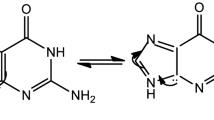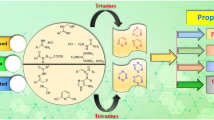Summary
The crystal and molecular structure of aminoguanidine hemioxalate, a salt in which aminoguanidine exists in the monocation form, was determined by single crystal X-ray diffraction. The salt crystallizes in the monoclinic space group P2(1)/n with unit cell dimensions ofa=4.95,b=10.46,c=10.40 Å, β=92.57°, andZ=4. The structure contains one oxalate ion for every two CN4H +7 ions, the latter being practically planar. The structure of the monocation is largely similar to those of aminoguanidine dications except that the monocation is devoid of one of the protons attached to the terminal hydrazine nitrogen. This result is of interest considering the synthesis of amidinohydrazones, indicating that the concentration of the active nucleophile is nearly maximal even when aminoguanidine exists in the monocation form. Therefore, the synthesis of amidinohydrazones should be performed in thepH range in which aminoguanidine exists mainly in the monocation form,i.e. at apH higher than 2. There is, however, no need to elevate thepH to values at which a considerable proportion of aminoguanidine exists as the free base.
Zusammenfassung
Die Kristallstruktur von Aminoguanidinhemioxalat, einem Salz, in dem Aminoguanidin als Monokation existiert, wurde mit Einkristallröntgenmethoden aufgeklärt. Das Salz kristallisiert in der monoklinen Raumgruppe P2(1)/n mit den Zellparameterna=4.95,b=10.46,c=10.40 Å, β=92.57° undZ=4. In der Einheitszelle kommt ein Oxalation auf je zwei flache CN4H +7 -Ionen. Die Struktur des Monokations ist bekannten Strukturen des Aminoguanidindikations ähnlich, mit der Ausnahme, daß dem Monokation eines der an das äußere Stickstoffatom der Hydrazingruppe gebundenen drei Protonen fehlt. Dieses Ergebnis ist interessant bezüglich der Synthese von Amidinohydrazonen, da es bedeutet, daß die Konzentration des aktiven Nukleophils auch dann beinahe maximal ist, wenn Aminoguanidin in der Monokationform vorliegt. Synthesen von Amidinohydrazonen sollten daher unter solchen Bedingungen ausgeführt werden, unter denen Aminoguanidin hauptsächlich in der Monokationform existiert (pH höher als 2). Es ist jedoch nicht nötig, beipH-Werten zu arbeiten, die so hoch sind, daß ein bedeutender Teil der Verbindung als freie Base vorliegt.
Similar content being viewed by others
References
Thiele J, Dralle E (1898) Liebigs Ann Chem302: 275
Richter PH, Wunderlich I, Schleuder M, Keckeis A (1993) Pharmazie48: 83
Richter PH, Wunderlich I, Schleuder M, Keckeis A (1993) Pharmazie48: 163
Elo H (1989) Thesis, Department of Biochemistry, University of Helsinki
Alhonen-Hongisto L, Fagerström R, Laine R, Elo H, Jänne J (1984) Biochem J221: 273
Seppänen P, Fagerström R, Alhonen-Hongisto L, Elo H, Lumme P, Jänne J (1984) Biochem J221: 483
Elo H, Laine R, Alhonen-Hongisto L, Jänne J, Mutikainen I, Lumme P (1985) Z Naturforsch40c: 839
Elo H, Mutikainen I, Alhonen-Hongisto L, Laine R, Jänne J, Lumme P (1986) Z Naturforsch41c: 851
Elo H, Mutikainen I, Alhonen-Hongisto L, Laine R, Jänne J (1988) Cancer Lett41: 21
Elo H, Koskinen M, Mutikainen I, Tilus P, Lampio A, Keso L, Vainio A, Joutsjoki V, Alli K, Yliniva A (1996) Anti-Cancer Drug Des11: 493
Jänne J, Alhonen-Hongisto L, Nikula P, Elo H (1986) Adv Enz Regul24: 125
Jänne J, Alhonen L, Leinonen P (1991) Ann Med23: 241
Seiler N, Bolkenius FN, Knödgen B (1985) Biochem J225: 219
Misko TP, Moore WM, Kasten TP, Nickols GA, Corbett JA, Tilton RG, McDaniel ML, Williamson JR, Currie MG (1993) Eur J Pharmacol233: 119
Mutikainen I, Elo H, Lumme P (1986) J Chem Soc Perkin Trans II, 291
Lumme P, Mutikainen I, Elo H (1986) Acta CrystallogrC42: 1209
Elo H, Mutikainen I (1988) Z Naturforsch43c: 601
Elo H (1989) Spectrosc Lett22: 123
Elo H (1989) Spectrosc Lett22: 161
Elo H, Soljamo K (1989) Spectrosc Lett22: 1141
Elo HO, Tilus PTE, Mutikainen IP, Heikkinen I, Riekkola ML (1989) Anti-Cancer Drug Des4: 303
Elo H (1990) Spectrosc Lett23: 877
Elo H (1992) Spectrosc Lett25: 1267
Soljamo K, Elo H (1992) Spectrosc Lett25: 1315
Mutikainen I, Elo H, Tilus P (1993) Z Naturforsch48b: 1821
Koskinen M, Elo H (1994) Spectrosc Lett27: 889
Koskinen M, Lummila J, Elo H (1994) Spectrosc Lett27: 1187
Koskinen M, Mutikainen I, Elo H (1996) Z Naturforsch51b: 1161
Koskinen M, Mutikainen I, Elo H (1994) Z Naturforsch49b: 556
Mutikainen I, Koskinen M, Elo H (1994) Pharmazie49: 739
Koskinen JT, Koskinen M, Mutikainen I, Mannfors B, Elo H (1996) Z Naturforsch51b: 1771
Kottke T, Stalke D (1993) J Appl Cryst26: 615
North ACT, Phillips DC, Mathews FS (1968) Acta CrystallogrA24: 351
Sheldrick GM (1990) SHELXTL PC, Release 4.1, Siemens Analytical X-Ray Instruments, Inc., Madison, WI, USA
Sheldrick GM (1993) SHELXL93, University of Göttingen, Germany
Author information
Authors and Affiliations
Rights and permissions
About this article
Cite this article
Koskinen, M., Mutikainen, I., Tilus, P. et al. Structure of aminoguanidine hemioxalate. Implications for the synthesis of amidinohydrazones. Monatsh Chem 128, 767–775 (1997). https://doi.org/10.1007/BF00807087
Received:
Accepted:
Issue Date:
DOI: https://doi.org/10.1007/BF00807087




